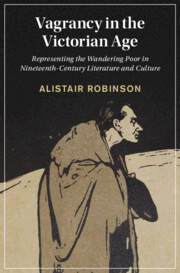 Vagrancy in the Victorian Age
Vagrancy in the Victorian Age Published online by Cambridge University Press: 02 November 2021
How were vagrants represented in the Victorian period? This chapter argues that the Victorians inherited many strategies of representation from the early modern period, including the moral concept of the deserving and undeserving poor, and stereotypes about the lawlessness, deceptiveness and rebelliousness of wanderers and itinerants. But they were also influenced by new epistemologies and ways of knowing. In particular, Victorian representations of vagrancy were influenced by emerging racial theories, such as extinction theory, degeneration theory, social Darwinism and eugenics. This chapter provides an overview of how these theories interlocked with older prejudices and moral frameworks, and in the process introduces the key vagrant archetypes addressed by this study: Gypsies, hawkers, poachers, casual paupers, loafers, pauper immigrants, American Indians, American vagabonds and beachcombers. Together, these figures comprise the taxonomy through which commentators understood, imagined and interpreted vagrancy in the Victorian age.
To save this book to your Kindle, first ensure [email protected] is added to your Approved Personal Document E-mail List under your Personal Document Settings on the Manage Your Content and Devices page of your Amazon account. Then enter the ‘name’ part of your Kindle email address below. Find out more about saving to your Kindle.
Note you can select to save to either the @free.kindle.com or @kindle.com variations. ‘@free.kindle.com’ emails are free but can only be saved to your device when it is connected to wi-fi. ‘@kindle.com’ emails can be delivered even when you are not connected to wi-fi, but note that service fees apply.
Find out more about the Kindle Personal Document Service.
To save content items to your account, please confirm that you agree to abide by our usage policies. If this is the first time you use this feature, you will be asked to authorise Cambridge Core to connect with your account. Find out more about saving content to Dropbox.
To save content items to your account, please confirm that you agree to abide by our usage policies. If this is the first time you use this feature, you will be asked to authorise Cambridge Core to connect with your account. Find out more about saving content to Google Drive.